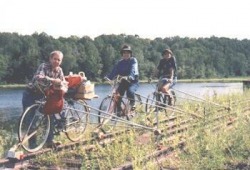Somehow only today, even though I am friends with many, many active and adventurous cyclists, I learned about railbiking!
SOME HISTORY:
There are thousands of miles of railway lines across the world. In 1855, the Panama Railway was completed. It stretched from ocean to ocean across a narrow stretch of Central America. In 1869 the United States completed the Transcontinental Railroad. That rail line stretched over more than 1,700 miles east to west. Soon followed the Southern Pacific Railway (New Orleans to Los Angeles), the Northern Pacific Railway (Chicago to Seattle), the Great Northern Railroad (St. Paul to Seattle) and others. The list grew, for a while.

For nearly as long as there have been railroads there have been railbikes. Draisines, common in Norway, Sweden and Denmark, were pedal-powered rail trolleys. Just as an old black and white film might bring to mind a hand-pump trolley, (picture a woman tied to the tracks, the train is coming, the trolley worker is pumping furiously to get to her, via a hand-powered-pump-style cart, just in time to help) in Sweden, Norway and Denmark such repair or rescue carts were foot-pedal-powered.
As the years passed, ingenuity was redirected. Automobiles moved into the spotlight. Railway tracks and their snazzy, human-powered cart-designs (those related to the railroad and those designed for independent recreation) were increasingly ignored. Today, the world continues to revise its approaches to transportation. Green technology and the, increasingly popular, self-sufficiency, back-to-basics ideas just might make the time ripe for the resurgence of the railbike.
Many old railroad lines still wind through beautiful stretches of U.S. countryside and organizations like Rails to Trails encourage appreciation of those paths. Rails to Trails encourages the removal of the tracks, to be replaced with paved or dirt paths, but railbike-enthusiasts might suggest the tracks stay put instead.
From the U.S., to China, to Costa Rica cyclists make use of inactive railway lines to explore via railbike. Some adventure tourism and eco-tourism companies promote railbikes as a creative way to be physically active and travel in a green-friendly style.
I am curious to learn how to make a bicycle railbike friendly. I imagine that a resurgence of railbiking could inspire creative construction sessions in communities. I can picture neighborhood kids messing with their bicycles, sharing tools and scrap materials to design railbikes or to design connective pieces to bind two or more bicycles together for a group track adventure. We could be on the brink of a new era that encourages kids to play on the tracks.
Do you know of inactive railway lines near you?
Thanks to Kat and Liz for introducing me to this idea indirectly. Liz has a page related to railbike adventures from DC to Montreal.

 RSS Feed
RSS Feed
